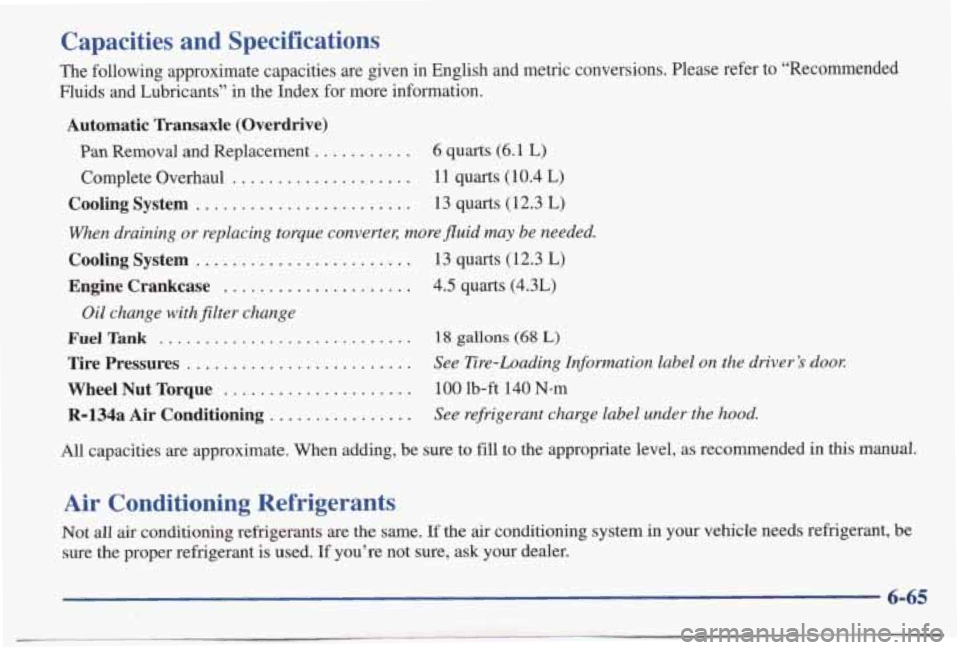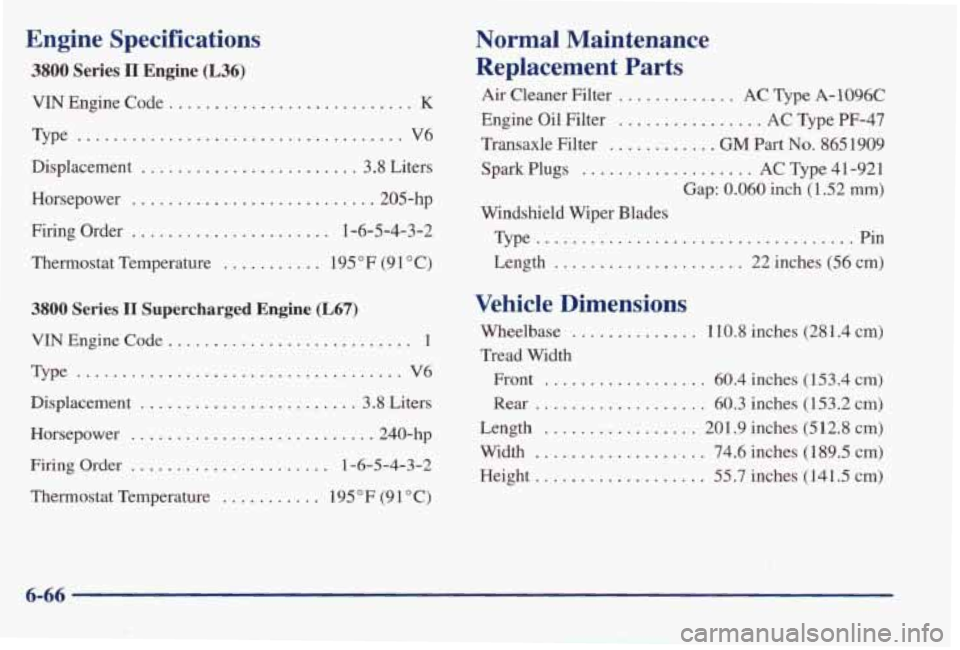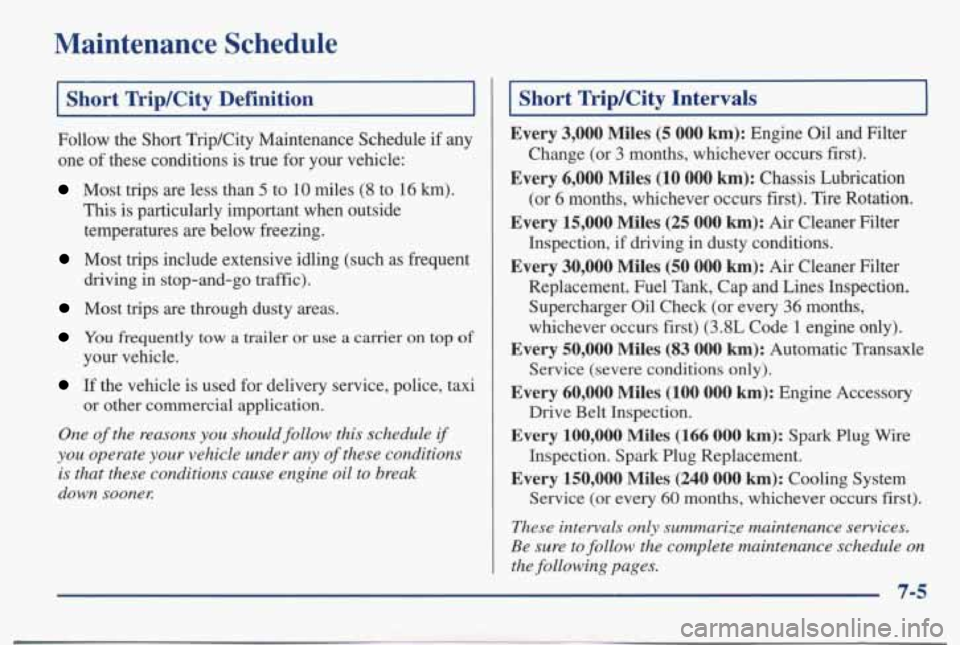Page 308 of 395
Vehicle Identification Number (VIN)
SAMPLE4UXWM072675 I
ENGINEA998 7 ASSEMBLY
CODE MODEL YEAR PLANT
This is the legal identifier for your vehicle. It appears
on a plate in the front corner of the instrument panel,
on
the driver’s side. You can see it if you look through the
windshield from outside your vehicle. The VIN also
appears on the Vehicle Certification and Service Parts
labels and the certificates of title and registration.
Engine Identification
The 8th character in your VIN is the engine code. This
code will help you identify your engine, specifications
and replacement parts.
Service Parts Identification Label
You’ll find this label on your spare tire cover. It’s very
helpful if you ever need to order parts. On this label is:
your VIN,
the model designation,
paint information and
a list of all production options and
special equipment.
Be sure that this label is not removed from the vehicle.
Page 313 of 395
Fuse
7D
8D
9D
1E
2E
3E
4E
5E
6E
7E
8E
9E
Usage
Not Used
Radio
Not Used
Not Used
Air
Bag System, PASS-Key
Not Used
Not Used Rear Defog
Not Used Non-OBD
II Engine Miscellaneous
Wipers, Washer
Not Used
Passenger’s Side Fuse Block
Additional fuses are located in the relay center, on the
passenger’s side, below the instrument panel. You must
remove the sound insulator
on the right side of the
passenger footwell
to replace these fuses.
Since replacing these fuses is difficult. We recommend
that you see your dealer
if you need one replaced.
6-62
Page 314 of 395
on
000
no
000
I CUM I I POSmONS I
0
no
0
00
0
on
17
00
0
on
Fuse
1
2
3
4
5
6
7
8
9
10
11
Q
Usage
Door Locks
Trunk Release, RAC
Horns
Not Used
Miscellaneous Engines Controls
(OBD II)
Fuel Pump
Injectors
Powertrain Contiol Module
Not Used
Not Used
NC Programmer
Not Used
6-63
Page 316 of 395

Capacities and Specifications
The following approximate capacities are given in English and m\
etric conversions. Please refer to “Recommended
Fluids and Lubricants” in the Index for more information.
Automatic Transaxle (Overdrive)
Pan Removal and Replacement ........... 6 quarts (6.1 L)
Complete Overhaul .................. 11 quarts (10.4 L)
Cooling System ........................ 13 quarts (12.3 L)
When draining or replacing torque converter; more fluid may be needed.
Cooling System ................ ........ 13 quarts (12.3 L)
Engine Crankcase ................... 4.5 quarts (4.3L)
Fuel Tank ............................ 18 gallons (68 L)
Tire Pressures .... >.. . See Ere-Loading Information label on the driver’s dool:
Wheel Nut Torque ......... . 100 lb-ft 140 N-m
R-134a Air Conditioning .... . See refrigerant charge label under the hood.
Oil
change with filter change
.......
.......
.......
All capacities are approximate. When adding, be sure to fill to the appropriate level, as recommended in this manual.
Air Conditioning Refrigerants
Not all air conditioning refrigerants are the same. If the air conditioning system in your vehicle needs refrigerant, be
sure the proper refrigerant is used. If you’re not sure,
ask your dealer.
6-65
Page 317 of 395

Engine Specifications
VIN Engine Code . . ................... K
Type ............ ~ ................ V6
Displacement
.................... 3.8 Liters
Horsepower
...................... .205-hp
Firing Order
...................... 1-6-5-4-3-2
3800 Series I1 Engine (L36)
Thermostat Temperature ........... 195°F (91°C)
Normal Maintenance
Replacement
Parts
Engine Oil Filter ................ AC Type PF-47
Transaxle Filter
............ GM Part No. 865 1909
Spark Plugs
................. AC Type 41-921
Air Cleaner Filter
............. AC Type A-1096C
Gap: 0.060 inch (1.52 mm)
Windshield Wiper Blades
npe
.................
Length .................
.............. Pin
. . 22 inches (56 cm)
3800 Series I1 Supercharged Engine (L67) Vehicle Dimensions
VIN Engine Code 1 .............. Wheelbase 110.8 inches (28 1.4 cm)
Tread Width ...........................
5pe .............. .................. V6
Front ........... . . 60.4 inches (153.4 cm)
Displacement
........................ 3.8 Liters
Horsepower
........................ .240-hp
Thermostat Temperature
........... 195°F (91°C)
Firing Order ...................... 1-6-5-4-3-2 Rear
................... 60.3 inches (1 53.2 cm)
Length
................. 201.9 inches (512.8 cm)
Width
................... 74.6 inches (189.5 cm)
Height
................... 55.7 inches (141.5 cm)
6-66
Page 318 of 395
L36 Engine Accessory Belt
The L36 engine uses an engine accessory belt. This
diagram shows the features connected and the routing.
See “Maintenance Schedule” in the Index for when to
check the belt.
B
F
A-
C
A. Power Steering
B. Generator C.
Air Conditioning
D. Crank
E. Coolant Pump
E Idler
L67 Engine Accessory Belt
The Supercharged 3800 (L67) engine uses two accessory drive belts. The inner belt drives the
generator, power steering pump, coolant pump and
air
conditioning. The outer belt drives the supercharger.
Each belt has its own tensioner and idler pulley. See “Maintenance Schedule” in the Index for when to check
the accessory
drive belts and the supercharger oil level.
Have your dealer check the
oil level in the supercharger.
F
1. Front Belt C. Crank
2. Back Belt D. Supercharger
A. Generator E. Coolant Pump
B. Power Steering Pump E Air Conditioning
Page 321 of 395
c
IMPORTANT: I
KEEP ENGINE OIL
AT THE PROPER
LEVEL AND CHANGE AS
RECOMMENDED
GM - 1
Have you purchased the GM Protection Plan? The Plan
supplements
your new vehicle warranties. See your
Warranty and Owner Assistance booklet, or your
Pontiac dealer for details.
Introduction
Your Vehicle and the Environment
Proper vehicle maintenance not only helps to keep your
vehicle in good working condition,
but also helps the
environment.
All recommended maintenance procedures
are important. Improper
vehicle maintenance can even
affect the quality of the air we breathe. Improper fluid
levels or
the wrong tire inflation can increase the level
of emissions from your vehicle. To help protect our
environment, and to keep your vehicle in good
condition, please maintain your vehicle properly.
7-2
Page 324 of 395

Maintenance Schedule
I Short TripKity Definition I
Follow the Short TripKity Maintenance Schedule if any
one
of these conditions is true for your vehicle:
Most trips are less than 5 to 10 miles (8 to 16 km).
This is particularly important when outside
temperatures are below freezing.
Most trips include extensive idling (such as frequent
driving in stop-and-go traffic).
Most trips are through dusty areas.
You frequently tow a trailer or use a carrier on top of
If the vehicle is used for delivery service, police, taxi
your vehicle.
or other commercial application.
One of the reasons you should follow this schedule if
you operate your vehicle under any of these conditions
is that these conditions cause engine oil to break
down soonex
Short Trip/City Intervals
Every 3,000 Miles (5 000 km): Engine Oil and Filter
Every 6,000 Miles (10 000 km): Chassis Lubrication
Every 15,000 Miles (25 000 km): Air Cleaner Filter
Every 30,000 Miles (50 000 km): Air Cleaner Filter
Change (or
3 months, whichever occurs first).
(or 6 months, whichever occurs first). Tire Rotation.
Inspection, if driving in dusty conditions.
Replacement. Fuel Tank, Cap and Lines Inspection.
Supercharger Oil Check (or every
36 months,
whichever occurs first)
(3.8L Code 1 engine only).
Every 50,000 Miles (83 000 km): Automatic Transaxle
Service
(severe conditions only).
Every 60,000 Miles (100 000 km): Engine Accessory
Drive Belt Inspection.
Every 100,000 Miles (166 000 km): Spark Plug Wire
Inspection. Spark Plug Replacement.
Every 150,000 Miles (240 000 km): Cooling System
Service (or
every 60 months, whichever occurs first).
These intervals only summarize maintenance services.
Be sure to follow the complete maintenance schedule on
the following pages.
RP